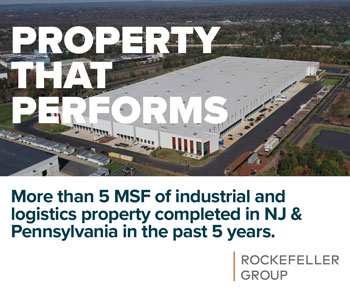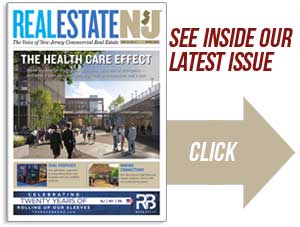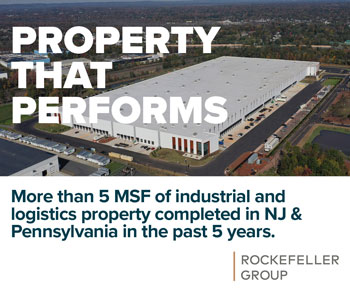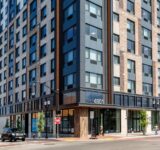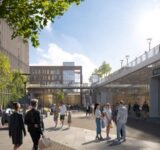Sandy Weiss, the founder and CEO of Manhattan Building Co. — Photo by Jeffrey Vock for Real Estate NJ
By Joshua Burd
For Sandy Weiss, the concept is nearly 30 years in the making, but the plan to redevelop a cluster of blighted industrial buildings in Jersey City is now taking shape.
The longtime Hudson County developer has delivered nearly 800 apartments since 2013 and has another 350 under construction, laying the groundwork for an emerging community just south of Hoboken and west of the Holland Tunnel. The response from renters has validated his belief in the types of neighborhoods that are critical to a city, he said, even if lenders and other investors were not as quick to buy in.
“That’s the core of any city,” said Weiss, the founder and CEO of Manhattan Building Co. “It’s more than just the waterfront. It’s being able to develop behind the waterfront and in secondary locations — and make and improve neighborhoods.”
Weiss and his firm now hope to bring that approach to another section of Jersey City — seeking to build on their experience of trying to build a new neighborhood from scratch. The company is the designated master redeveloper for about four city blocks just east of the New Jersey Turnpike extension, where it has proposed building more than 2,300 apartments for a mix of income levels.
Located between Bates and Center streets, at the edge of the downtown, the nine-acre tract is part of a redevelopment plan adopted by the city in 2006. That plan has spurred controversy and litigation in recent years, as individual property owners have jockeyed for the right to build on their lots. But those owners are now slated to enter into sub-redeveloper agreements with MBC and the Jersey City Redevelopment Authority, clearing the way for the plan to move forward.
To that end, the firm in recent months has hosted meetings with city officials and residents, part of what Weiss expects to be a long cycle of community engagement. He knows that feedback from stakeholders will inevitably lead to design and density changes, but believes that density is the key component to “cracking the code” of creating affordable and workforce housing without using subsidies.
The most recent proposal called for 1,700 units across four towers, according to a recent report by The Jersey Journal, after a previous version earlier this summer contemplated nearly 2,400 units.
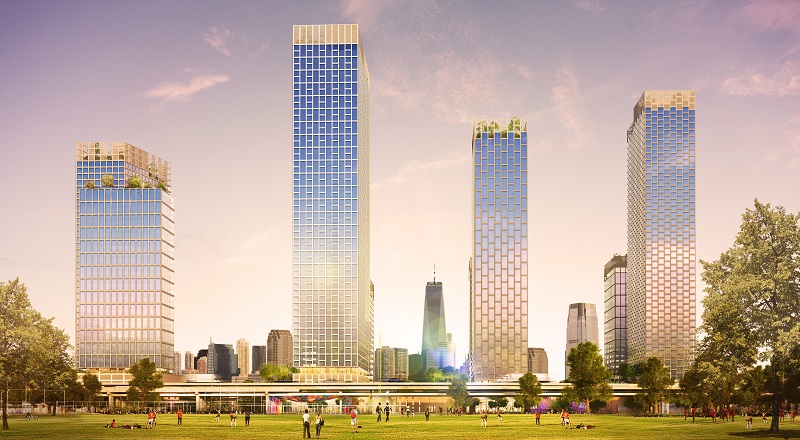
“It’s the most classic urban renewal I’ve ever seen,” said Weiss, who has been building in Hoboken and Jersey City since the late 1970s. He noted that the existing neighborhood along Bates Street includes a host of empty lots and run-down commercial buildings, in a location that suffers from dated water and sewer lines.
“It’s an area in need of taking it from A to Z, (demolish) it, put the infrastructure in and then build — just like they do in New York City — in a professional manner,” he said. “And we’re trying to get everyone to buy into it.”
MBC has also worked with Ward F Councilman Jermaine Robinson and other stakeholders who have voiced concerns that the project could create a wall of buildings, cutting off the neighborhoods to the west. Robinson said as much in a recent op-ed published by The Jersey Journal.
“This wall would make a stark separation between the perceived luxury neighborhoods Downtown and the many low-income neighborhoods in Bergen-Lafayette,” he wrote in the May 29 column. “Worse, it will result in a series of buildings forming a similarly designed ‘wall’ that will prevent the needed connectivity between neighborhoods.”
Weiss said he and his team have heard those concerns loud and clear, noting that current plans call for taller, more slender buildings.
“(We’re) making sure that there is a corridor through to the waterfront, which was important to the city and I think is the right thing to do: Don’t just build a block so that when you’re driving by, you see a wall of 10-story buildings,” Weiss said. “It separates neighborhoods.”
MBC is currently working with the city to change the zoning and was not seeking entitlements as of early July, the firm said. But completing the zoning phase could allow it to obtain approvals by early next year.
As that process continues, the firm will undoubtedly draw on its experience at what is now known as Soho West, its ongoing redevelopment near the Holland Tunnel and Hoboken’s southern border. Weiss has sought to build in the area since the early 1990s, when he secured approvals to build some 280 units, but found it hard to obtain financing for a neighborhood that was unproven and dominated by aging warehouses.
MBC broke ground two decades later, giving way to a 155-unit building along Jersey Avenue between 17th and 18th streets. Known as Cast Iron Lofts, the luxury apartment tower saw strong demand after opening in 2013, prompting MBC to launch a second phase with another 232 units.
“Between recessions, depressions, whatever it was, it takes a long time to get the economic cycles to be correct, especially for non-waterfront projects,” Weiss said. But he believes the larger-than-average floorplans at Cast Iron Lofts were a distinguishing factor for the complex, which still offered the comforts and upscale amenities of Jersey City’s waterfront.
MBC continued that formula with its next phase at Soho West, a 377-unit project known as Soho Lofts, which opened about a block south of Cast Iron Lofts.
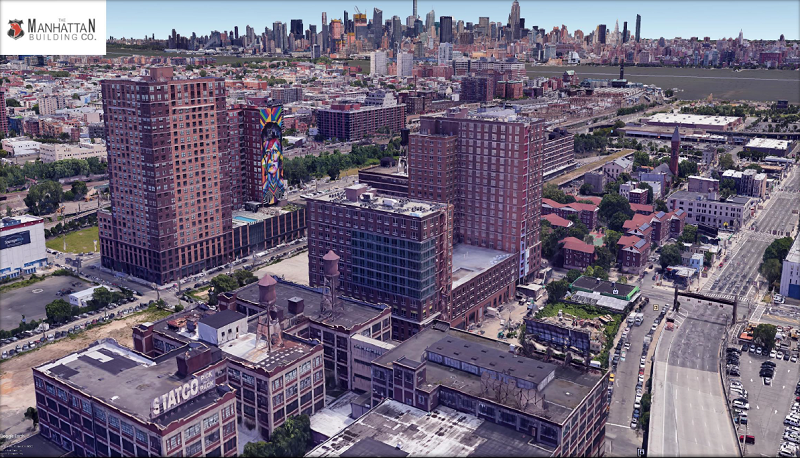
“We want it to be a home,” Weiss said. “Even though it’s an apartment, I want it to feel as if I would live there and that this is what I would want, so if it’s good for me, then it’s good for the building. And you want space, especially in the secondary locations. It’s one of the reasons people will come back here — for more space and a better place to live.”
The buildings are all close to or at full occupancy, housing roughly 1,600 residents. And Weiss says lenders have now “bought into the concept” that he has pursued for nearly 30 years.
So have other developers: A team of BNE Real Estate Group, Hoboken Brownstone Co. and McKinney Properties recently debuted a new 260-unit apartment complex just west of MBC’s buildings, the first of three upscale projects that the joint venture is planning.
Weiss, meantime, notes that a preschool is among the early retailers that have opened at Cast Iron Lofts’ ground-floor commercial space, which serves as another amenity to the families that have moved to the neighborhood.
“What’s most important about these buildings is that, for me, it’s the beginning of a new model for how to give the new generation and older generations a great living experience,” he added. “That’s what these buildings have accomplished.”
That’s not to say that Soho West is a finished product — not by any means, as Weiss freely admits. While MBC hopes to build a total of roughly 2,000 units in the neighborhood, the area still lacks the infrastructure and commercial offerings that will make for a cohesive community.
The firm is now trying to address that challenge in concert with city officials.
“If you even look at the parking garages, the way the cars and people move, it’s not a lot of activity,” Weiss said. “We should not be scared of density. It is our friend: It brings safety, it makes neighborhoods, it’s what makes urban America real.”
Long-term plans include reconnecting the street grid west of Coles Street, separating the combined water and sewer lines and raising the roads above flood elevation, MBC executives say. The firm, which is also planning new park space, is in the midst of ongoing discussions with the city and expects that the improvements will be completed in phases as Soho West continues to develop.
The process has reinforced the need to complete the infrastructure at the firm’s other large undertaking — the Bates Street redevelopment area — before any buildings go up.
“We really see that as the next Soho West — except that what we want to do is not do it piecemeal,” Weiss said, later adding: “We’re trying to do it correctly up front.”
The developer is confident that he can do so with the help of Jersey City’s planning and construction departments, which he calls “a professional operation” that is able to grasp the bigger picture.
A key priority of that plan is to remedy the major water infrastructure problems that exist at the site today. MBC is also working with city officials and state transportation officials on a plan to connect the two neighborhoods that are currently separated by the Turnpike extension along Interstate 78. Weiss notes that, on the other side of the highway, the neighborhood is home to the popular Gateway Park.
“It’s a hidden gem and we want to open it up,” he said. “How do you open it up? With human beings.”
MBC executives say that, if the plan is successful, it could serve as a model for what the firm aims to do near Soho West: create a pedestrian pathway along Coles Street that would connect the neighborhood to Hamilton Park. That would involve improving underutilized space beneath the approach roadway to the Holland Tunnel.
Such a project would create additional open space beyond what MBC and city officials are already planning for Soho West. Those plans call for a 1.5-acre passive park west of Coles Street between 16th and 18th streets, which the firm expects to be completed by early 2021.
“We’re going to try to take a little piece of Central Park out of Central Park and put it right here,” Weiss said.



